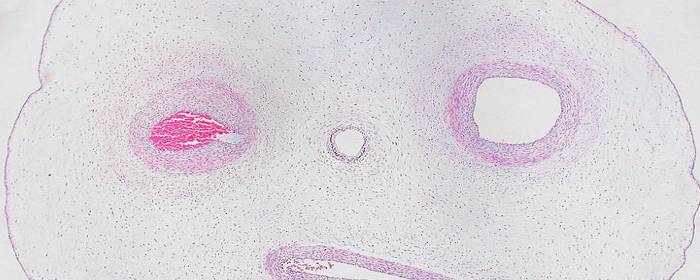
by admin | Oct 4, 2018 | Stem Cell Therapy, Lupus, Wharton's Jelly
Wharton’s jelly is a rather unique body fluid. It is the connective tissue found within the umbilical cord. While Wharton’s jelly is connective tissue, it more closely resembles gelatin. Historically this material was discarded as medical waste; however, Wharton’s jelly has been shown to contain a number of therapeutic substances. Among these healing substances found within Wharton’s jelly is an abundant supply of mesenchymal stem cells.
One of the most intriguing features of Wharton’s jelly is that it contains a virtually limitless supply of mesenchymal stem cells. There are about 4 million new births in the United States each year, 5 million in the European Union, and over 100 million worldwide. The potential pool of cells is staggering when you consider only a small amount of Wharton’s jelly can contain millions of stem cells. Notably, Wharton’s jelly is usually discarded after the delivery of a healthy baby. If this material could be donated instead of discarded, researchers believe they have found an abundant, renewable resource from which to draw mesenchymal stem cells.
However, the abundance of Wharton’s jelly is not the most impressive feature of the substance. The stem cells found in Wharton’s jelly are rather unique. Perhaps most importantly, the cells are immuno-privileged. This means they are not readily recognized by the immune system. Consequently, the stem cells can be taken from the umbilical cord, purified, and then injected into a patient with little risk of the patient having an immune reaction to the cells. These particular mesenchymal stem cells are also interesting because they are relatively “primitive,” which means they have some of the same properties of embryonic stem cells. However, Wharton’s jelly can be obtained without controversy, while harvesting embryonic stem cells from aborted tissue remain highly controversial.
Stem cells taken from Wharton’s jelly are already being used in some clinical studies. For example, researchers in one clinical study injected type 2 diabetes patients with Wharton’s jelly-derived mesenchymal stem cells. Within six months of treatment, 7 of 22 patients became insulin-free and 5 were able to reduce the amount of insulin they needed by more than 50%. Only one patient out of the 22 did not respond to the stem cells at all. The cells have also been tested in systemic lupus erythematosus, better known as simply lupus. Forty patients received Wharton’s jelly mesenchymal stem cells intravenously. Thirteen patients enjoyed a major clinical response while 11 enjoyed a partial clinical response of their lupus symptoms.
As more clinical studies are done on Wharton’s jelly-derived mesenchymal stem cells, we will learn what other diseases can be treated with this once-discarded substance. Early indications show a very promising future.

by admin | Sep 18, 2018 | Bone Marrow
The knee is a complex joint that must support the weight of the body while allowing the leg to bend freely. An important part of the knee joint is the meniscus. The meniscus is a fibrous cartilage structure that acts as a shock absorber. While these menisci perform very well during various strenuous activities, they can and do tear. In fact, a torn meniscus in the knee is one of the most common orthopedic injuries.
A torn meniscus of the knee often causes pain and swelling in the knee. Patients with a torn meniscus cannot squat or kneel, and the knee joint does not move smoothly. In fact, many patients with a torn meniscus describe the joint as popping, locking, catching or even “giving out.”
The meniscus of the knee can be torn in several ways; however, most torn menisci result from either one of two things: athletic activity or degenerative arthritis. As you would imagine, menisci torn during sport occur more commonly in young athletes such as dancers, certain kinds of track and field athletes, and basketball, soccer and football players. People with degenerative arthritis tend to be older and often have careers that require a lot of bending at the knee, such as carpet layers, carpenters, plumbers, etc.
Some people can live with small tears in their knee meniscus, but many people ultimately require surgery to fix the problem. One of the major approaches is to perform a total or partial meniscectomy of the damaged knee meniscus. Generally speaking, surgeons offer partial meniscectomy because patients heal faster, and results are about as good as a total meniscectomy. Unfortunately, surgical repair of these tissues is not always successful, especially in older individuals with tears related to degenerative arthritis. Consequently, surgical researchers are keen to discover new ways to improve partial meniscectomy to help people with meniscal tears of the knee.
One exciting option is using stem cells to potentially help patients regrow healthy meniscus after surgeons remove the damaged portion.
In one study, orthopedic surgeons at various surgical centers around the United States participated in an I/II, randomized, double-blind, controlled study to study the effects of human mesenchymal stem cells in people with a meniscal tear of the knee. Researchers recruited 60 patients who were eligible to receive a partial meniscectomy and sorted them into three groups: treatment group A received 50 million human mesenchymal stem cells, group B received 150 million stem cells, and group C (the control group) simply received an infusion of salt water. Patients received an injection of stem cells into the knee, 7 to 10 days after their partial meniscectomy surgery. Then researchers followed the patients for six weeks, six months, one year, and two years after the procedure.
Researchers found that some patients who received human mesenchymal stem cells had a significant increase in the size of their menisci after surgery. By contrast, no single patient in the control group had an increase in the size of their menisci. In other words, stem cells were found to be able to increase the size of the knee meniscus in some patients, as originally hypothesized. Likewise, the study authors could find no clinically important safety issues from injecting stem cells into the knees of patients. Perhaps most importantly, people who received mesenchymal stem cells reported a significant reduction in the amount of pain they experienced due to degenerative changes in the knee. In other words, partial meniscectomy plus stem cells apparently helped patients with degenerative arthritis of the knee.
The authors concluded that this research shows that human mesenchymal stem cells have the potential to be able to repair knee meniscus tissue and improve knee pain in people with meniscal tears. While additional research is needed, these results are very exciting for people who have torn menisci, especially older patients whose knee pain is a result of osteoarthritis or degenerative joint disease in the knee.

by admin | Sep 13, 2018 | Stem Cell Research, Stem Cell Therapy, Studies
Patients usually recover from bone fractures with the right treatment, but sometimes the bone fails to heal because new tissue does not form and connect the broken pieces properly. Delayed union refers to cases where the bone takes longer than usual to heal, and nonunion refers to cases where the bone does not heal. In approximately 5 to 10 percent of cases of a fractured bone, delayed union or nonunion occurs. These conditions are associated with long-term pain and discomfort, and though can be addressed through surgical treatments, these interventions do not always lead to long-term healing.
In recent years, researchers have begun exploring the potential for mesenchymal stem cells to help address these important challenges of delayed union and nonunion. A review of the potential for these stem cells to help in these cases where fractures do not properly heal was recently published in the Journal of Biomedical Materials Research.
Mesenchymal stem cells are helpful in bone healing because they differentiate well and can differentiate into different cell lineages that are all important for bone formation, growth, and maintenance. These cell types include chondrocytes, osteoblasts, myoblasts, and adipocytes.
According to the authors of the review, mesenchymal stem cells can be used in conjunction with extracellular matrix scaffolds and biological adjuvants that promote growth, differentiation, and blood vessel formation, to help in the bone healing process when the delayed union or nonunion occurs. Future research will help to determine the best ways that mesenchymal stem cells can be used in combination with bioengineering strategies to help patients whose bone fractures do not heal or do not heal properly.

by admin | Sep 7, 2018 | Stem Cell Therapy
Multipotent stem cells have the ability to turn into a number of different cells in the body, making them one of the most versatile solutions in regenerative medicine. They are also characterized by their capacity for self-renewal. Here, we take a look at their current applications, as well as their benefits.
What Makes Multipotent Stem Cells Unique?
To understand the distinguishing features of multipotent stem cells, we must first look at the different types of stem cells. There are three main classifications for the varying degrees of stem cell flexibility:
- Totipotent: These cells can turn into any cell in the body and are only found within the first couple of cell divisions following the fertilization of a female egg by a male sperm.
- Pluripotent: During embryonic development, totipotent cells specialize into pluripotent cells. They can give rise to all cells in the human body but aren’t quite as flexible as totipotent cells.
- Multipotent: Finally, pluripotent stem cells specialize into multipotent stem cells, which have been found in cord blood, cord tissue, adipose tissue, cardiac cells, bone marrow, and mesenchymal stem cells (MSCs).
What Are Multipotent Stem Cells Used for?
Not only are multipotent stem cells able to renew themselves almost indefinitely, their ability to become any other cell makes them a powerful agent in treating patients with tissue damage. From knees to other joints and even the gastrointestinal tract, there are many sites in the body where compromised tissue can benefit tremendously from stem cells. They can even help arthritis sufferers and individuals with tendonitis. Because stem cells can also replenish dying or damaged tissue of specialized cell types, multipotent stem cells can also benefit individuals with chronic illnesses such as COPD, multiple sclerosis (MS), and Parkinson’s disease.
What Are the Benefits of Multipotent Stem Cells?
Multipotent stem cells are advantageous because they can be sourced from a number of locations, including the Wharton’s Jelly which lines umbilical cord vessels, as well as fat tissue (adipose stem cells) and bone marrow aspirate. These cells can then be delivered via non-invasive regenerative therapy to replace damaged cells with new ones, which have the ability to help increase energy and control symptoms in chronic conditions. The treatment can also potentially spur healthy tissue development in musculoskeletal injuries, and when injected directly into the joint, it has the potential to promote healing of ligaments, tendons, and cartilage to help return functionality and in some cases could delay the need for joint replacement.





 St. Petersburg, Florida
St. Petersburg, Florida
